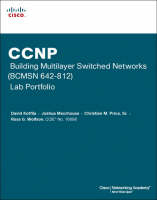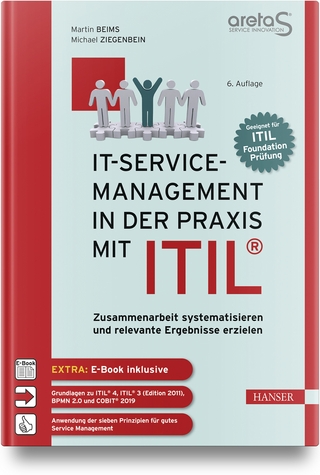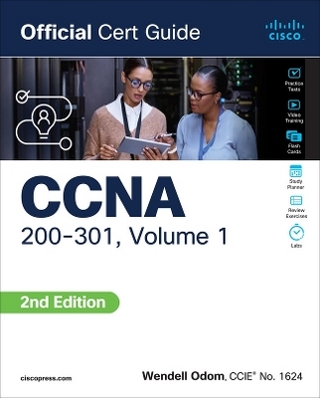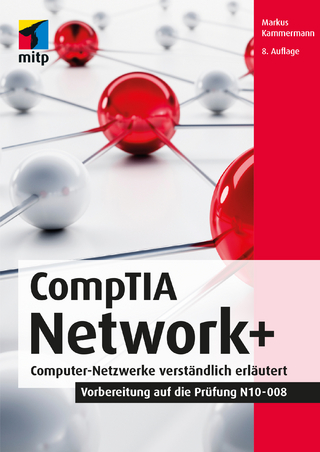
CCNP Building Multilayer Switched Networks (BCMSN 642-812) Lab Portfolio (Cisco Networking Academy)
Cisco Press (Verlag)
978-1-58713-214-8 (ISBN)
- Titel erscheint in neuer Auflage
- Artikel merken
The labs reinforce your understanding of how to install, configure, monitor, and troubleshoot network infrastructure equipment to deploy state-of-the-art campus LANs. The book focuses on the selection and implementation of the appropriate Cisco® IOS® services to build reliable, scalable, multilayer-switched LANs. Other topic areas of the course include VLANs, Spanning Tree Protocol, wireless client access, minimizing service loss, and minimizing data theft in a campus network.
Those preparing for the Building Multilayer Switched Networks (BCMSN 642-812) certification exam should work through this book cover-to-cover. If you need to quickly review configuration examples, you can go directly to the relevant chapter.
CCNPBuildingMultilayer Switched Networks (BCMSN 642-812) Lab Portfolio includes
19 Labs built to support v5 of the Building Multilayer Switched Networks course within the Cisco Networking Academy curriculum providing ample opportunity to practice.
2 Challenge and Troubleshooting Labs have been added to the core curriculum to test your mastery of the topics.
2 Case Studies to give you a taste of what is involved in a fully functioning switching network covering all the technologies taught in this course. Even if you do not have the actual equipment to configure these more complex topologies, it is worth reading through these labs to expand your thinking into more complex networking solutions.
David Kotfila, CCNP®, CCAI, is the director of the Cisco Networking Academy at Rensselaer Polytechnic Institute (RPI), Troy, New York.
Joshua Moorhouse, CCNP, recently graduated from Rensselaer Polytechnic Institute with a bachelor of science in computer science, where he also worked as a teaching assistant in the Cisco Networking Academy. He currently works as a network engineer at Factset Research Systems.
Christian M. Price Sr., CCNP, is an instructor in the Cisco Networking Academy at Rensselaer Polytechnic Institute in Troy, New York.
Ross Wolfson, CCIE® No. 16696, recently graduated from Rensselaer Polytechnic Institute with a bachelor of science in computer science. He currently works as a network engineer at Factset Research Systems.
Use this Lab Portfolio with:
CCNP BCMSN Official Exam Certification Guide
Fourth Edition
ISBN-10: 1-58720-171-2
ISBN-13: 978-1-58720-171-4
CCNP BCMSN Portable Command Guide
ISBN-10: 158-720-188-7
ISBN-13: 978-158720-188-2
This book is part of the Cisco Networking Academy Series from Cisco Press®. Books in this series support and complement the Cisco Networking Academy curriculum.
David Kotfila, CCNP, CCAI, is the director of the Cisco Academy at Rensselaer Polytechnic Institute (RPI), Troy, New York. Under his direction, 350 students have received their CCNA, 150 students have received their CCNP, and 8 students have obtained their CCIE. David is a consultant for Cisco working as a member of the CCNP assessment group. His team at RPI has authored the four new CCNP lab books for the Academy program. David has served on the National Advisory Council for the Academy program for four years. Previously, he was the senior training manager at PSINet, a Tier 1 global ISP. When David is not staring at his beautiful wife Kate or talking with his two wonderful children, Chris and Charis, he likes to kayak, hike in the mountains, and lift weights. Joshua Moorhouse, CCNP, recently graduated from Rensselaer Polytechnic Institute with a BS in computer science. While there, he also worked as a teaching assistant in the Cisco Networking Academy. He currently works as a network engineer at Factset Research Systems in Norwalk, Connecticut. Josh enjoys spending time with his wife Laura, his family, and friends. Christian M. Price Sr., CCNP, attended Hudson Valley Community College in Troy, New York, where he studied computer information systems. From 1997 to 2001, he worked for PSINet, one of the first Internet service providers and a major player in the commercialization of the Internet. Christian worked as a technical project manager with the Carrier and ISP Services group during his time at PSINet. He currently works with a credit union focusing on LAN/WAN design and implementation as well as implementation of a VoIP infrastructure for the organization. Christian is also an instructor in the Cisco Academy at Rensselaer Polytechnic Institute in Troy, New York. He lives with his loving wife and children in Grafton, New York. Ross G. Wolfson, CCIE No. 16696, recently graduated from Rensselaer Polytechnic Institute (RPI) with a BS in computer science. He currently works as a network engineer at Factset Research Systems. Ross enjoys spending time with his friends, running, and biking.
Chapter 1 Network Requirements 1
Lab 1-1: Lab Configuration Guide 1
Hardware and Software 2
Chapter 6: Wireless LANs 3
Chapter 2 Defining VLANs 5
Lab 2-0a: Clearing an Isolated Switch (2.6.1) 5
Step 1 Getting Connected 5
Step 2 Deleting vlan.dat 5
Step 3 Erasing the startup-config File 6
Step 4 Reloading 6
Step 5 Ready for Configuration 9
Lab 2-0b: Clearing a Switch Connected to a Larger Network (2.6.1) 10
Step 1 Clearing an Isolated Switch 10
Step 2 Deleting vlan.dat 10
Step 3 Erasing the startup-config File 10
Step 4 Relearning VLANs from a Server 11
Step 5 Eliminating Relearned VLANs 12
Step 6 VTP Mode Transparent 13
Lab 2-1: Catalyst 2960 and 3560 Series Static VLANs, VLAN Trunking, and
VTP Domain and Modes (2.6.2) 14
Scenario: VLAN Trunking and Domains 14
Step 1 Preparing the Switch 14
Step 2 VLAN 1 15
Step 3 show vlan 15
Step 4 VTP Modes 17
Step 5 VTP Domains 18
Step 6 Dynamic Auto Trunking 19
Step 7 show interface Commands 21
Step 8 Switchport Mode Commands 23
Step 9 show vtp status 25
Step 10 VLAN Database 26
Step 11 Switchport Access VLAN 28
Step 12 Naming VLANs 29
Step 13 Preparation for the Next Lab 30
Chapter 3 Implementing Spanning Tree 31
Lab 3-1: Spanning Tree Protocol (STP) Default Behavior (3.5.1) 31
Scenario: How Spanning Tree Prevents Loops 31
Step 1 Basic Configurations 31
Step 2 BPDUs 32
Step 3 show spanning tree 32
Step 4 Diagraming Spanning Tree 36
Challenge: A New Root for Spanning Tree 36
Lab 3-2: Modifying Default Spanning Tree Behavior (3.5.2) 37
Scenario: Logically Removing Bridging Loops 37
Step 1 Deleting vlan.dat 37
Step 2 Verifying the Root Bridge 37
Step 3 Changing the Primary and Secondary Root 40
Step 4 Changing Forwarding and Blocking Ports 42
Step 5 PortFast 44
Step 6 Modifying Port Costs 46
Lab 3-3: Per-VLAN Spanning Tree Behavior (3.5.3) 49
Scenario: Configuring Spanning Tree Differently for Different VLANs 49
Step 1 Basic Preparation 49
Step 2 Setting up VTP Domains 49
Step 3 Modifying Spanning Tree on a per-VLAN Basis 52
Step 4 RSTP 58
Challenge: Spanning Tree Root Primary 60
Lab 3-4: Multiple Spanning Tree (3.5.4) 62
Scenario: Configuring Multiple Spanning Tree 62
Step 1 Basic Preparation 62
Step 2 VTP Domain Setup 62
Step 3 Verifying 11 Instances of Spanning Tree 63
Step 4 spanning-tree mode mst 66
Step 5 Grouping VLANs Using MST 67
Challenge: Modifying per-instance MST Attributes 70
Lab 3-5: Configuring EtherChannel (3.5.5) 72
Scenario: Bundling Redundant Links into One Logical Link 72
Step 1 Basic Preparation 72
Step 2 channel group mode desirable 72
Step 3 channel group mode active 75
Step 4 Configuring EtherChannel on Layer 3 Connections 75
Step 5 Traffic Load Balancing 76
Challenge: Logically Aggregating Additional Redundant Links 77
Chapter 4 Implementing Inter-VLAN Routing 79
Lab 4-1: Inter-VLAN Routing with an External Router (4.4.1) 79
Scenario: A Cost Effective Solution to Segment a Network into Multiple
Broadcast Domains 79
Step 1 Basic Preparation 79
Step 2 Configuring up the Gateway and ISP Router 79
Step 3 ip default-gateway 80
Step 4 Verify Existing VLANs 81
Step 5 Configuring Trunking and EtherChannel 82
Step 6 Configuring the VTP Domain 83
Step 7 Configuring Switch Access Ports for Hosts 83
Step 8 Trunking with the External Router 83
Step 9 Trunking for VLANs 1, 100, and 200 84
Step 10 Verify inter-VLAN Routing 86
Lab 4-2: Inter-VLAN Routing with an Internal Route Processor and Monitoring
CEF Functions (4.4.2) 87
Scenario: Configuring Switched Virtual Interfaces to Route Between
VLANs 87
Step 1 Basic Preparation 87
Step 2 Basic Configuration 87
Step 3 Configuring Trunks and EtherChannel 89
Step 4 Changing the VTP Mode 91
Step 5 Creating the VTP Domain 92
Step 6 Configuring the Host Ports 92
Step 7 Creating Layer 3 VLAN interfaces 93
Step 8 Verifying inter-VLAN Routing 94
Step 9 CEF 94
Chapter 5 Implementing High Availability in a Campus Environment 99
Lab 5-1: Hot Standby Router Protocol (5.4.1) 99
Scenario: Redundant, Fault-tolerant Routing to the Internal Network 99
Step 1 Basic Preparation 99
Step 2 Basic Configuration 99
Step 3 Configuring Trunks and EtherChannel 101
Step 4 Changing the VTP Mode 104
Step 5 Creating the VTP Domain 105
Step 6 Configuring the Host Ports 105
Step 7 HSRP Configuration 106
Step 8 show standby 108
Step 9 Verify Connectivity Between VLANs 112
Step 10 Verify HSRP 112
Lab 5-2: HSRP Troubleshooting (5.4.2) 113
Initial Configurations 113
Lab 5-3: Gateway Load Balancing Protocol 114
Step 1 Basic Preparation 114
Step 2 Basic Configuration 114
Step 3 GLBP Configuration and Verification 114
Step 4 Adjusting the Weight to Prefer Certain Routers 120
Chapter 6 Wireless LANs 125
Option 1: Using the External WLAN Controller 125
Option 2: Using the WLAN Controller Network Module 127
Lab 6-1a: Configuring an External WLAN Controller (6.7.1a) 129
Step 1 Basic Preparation 130
Step 2 Basic Configuration 130
Step 3 Configuring the Switched Virtual Interfaces 132
Step 4 DHCP 132
Step 5 PortFast 133
Step 6 Configuring the Host and Host Port 134
Step 7 Enable and Verify Routing 136
Step 8 WLAN Controller Wizard 136
Step 9 Additional WLAN Controller Configuration 138
Lab 6-1b: Configuring a WLAN Controller Installed in a Router (6.7.1b) 139
Step 1 Basic Preparation 139
Step 2 VLAN and VTP Domain Configuration 139
Step 3 Subinterfaces 140
Step 4 DHCP 141
Step 5 PortFast 142
Step 6 Configuring the Host and Host Port 142
Step 7 Verify Routing 144
Step 8 WLAN Controller Wizard 145
Step 9 Additional WLAN Controller Configuration 147
Lab 6-2: Configuring a WLAN Controller via the Web Interface (6.7.2) 149
Step 1 Load Existing Configurations from Previous Lab 150
Step 2 Using the Web Interface for Configuration 150
Step 3 Creating Logical Interfaces 152
Step 4 Configuring WLANs That Correspond to the VLANs 155
Lab 6-3: Configuring a Wireless Client (6.7.3) 158
Step 1 Install Cisco Aironet Wireless Card Software 159
Step 2 Inserting the Cisco 802.11 a/b/g Wireless Adapter 163
Step 3 Verify Status of Installation 166
Chapter 7 Configuring Campus Switches to Support Voice 169
Lab 7-1: Configuring Switches for IP Telephony Support (7.3.1) 169
Scenario: Preparing the Switching Network to Support Voice 169
Step 1 Basic Preparation 170
Step 2 Basic Configuration 170
Step 3 Configure the Trunks and EtherChannel 171
Step 4 Changing the VTP Mode 173
Step 5 Creating the VTP Domain 174
Step 6 HSRP 174
Step 7 Auto QoS Configuration 176
Step 8 Verify Auto QoS 177
Step 9 Configure the Distribution Layer to Trust CoS 177
Step 10 Verify Auto QoS at the Distribution Layer 178
Step 11 mls qos cos 179
Chapter 8 Minimizing Service Loss and Data Theft in a Campus Network 181
Lab 8-1: Securing the Layer 2 Switching Devices (8.7.1) 181
Scenario: Layer 2 Threats 181
Step 1 Basic Preparation 182
Step 2 Basic Configuration 182
Step 3 Configuring VLANs and VTP 184
Step 4 Layer 2 Attacks and Mitigation 186
Step 5 Protecting Against MAC Flooding 187
Step 6 DHCP Spoofing 188
Step 7 AAA 191
Lab 8-2: Securing Spanning Tree Protocol (8.7.2) 193
Scenario: Protecting the Root Bridge and Preventing Rogue Access Points 193
Step 1 Verify Configurations from Lab 8-1 193
Step 2 Locking Down the Spanning Tree Root 197
Step 3 spanning-tree guard root 199
Step 4 Verify Root Guard 199
Step 5 BPDU Guard 201
Step 6 UDLD 202
Lab 8-3: Securing VLANs with Private VLANs, RACLs, and VACLs
(8.7.3) 204
Scenario: Configuring the Network to Secure VLANs 204
Step 1 Verifying Loaded Configurations 204
Step 2 Private VLANs 207
Step 3 RACLs 210
Step 4 VACLs 211
Chapter 9 Case Studies 213
Case Study 1: VLANs, VTP, and Inter-VLAN Routing 213
Case Study 2: Voice and Security in a Switched Network 215
| Erscheint lt. Verlag | 10.1.2008 |
|---|---|
| Verlagsort | Indianapolis |
| Sprache | englisch |
| Maße | 277 x 220 mm |
| Gewicht | 564 g |
| Themenwelt | Mathematik / Informatik ► Informatik ► Netzwerke |
| Informatik ► Weitere Themen ► Zertifizierung | |
| ISBN-10 | 1-58713-214-1 / 1587132141 |
| ISBN-13 | 978-1-58713-214-8 / 9781587132148 |
| Zustand | Neuware |
| Haben Sie eine Frage zum Produkt? |
aus dem Bereich


